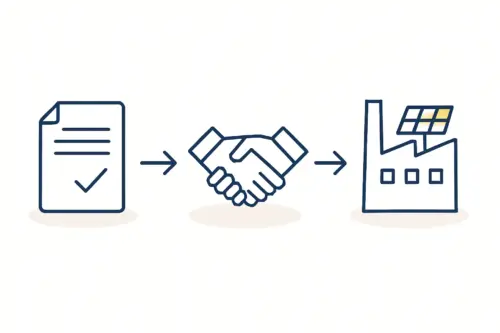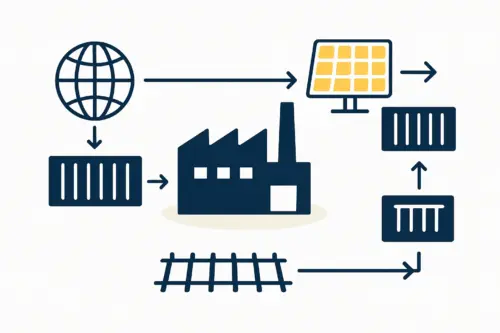For entrepreneurs entering the solar module manufacturing industry, acquiring the right machinery and a suitable facility are often the primary focus. Yet a less visible but equally critical component is the human capital—the skilled engineers and researchers who drive production, innovation, and quality control. The global demand for these specialists is intensifying, creating a significant challenge for new market entrants.
One strategic, yet often overlooked, solution is direct collaboration with world-renowned technical universities. This approach goes beyond traditional recruitment to create a sustainable talent pipeline and a direct channel to cutting-edge research. This article explores how to establish such partnerships, focusing on two of Sweden’s engineering powerhouses: KTH Royal Institute of Technology and Chalmers University of Technology.
Why University Collaboration is a Strategic Imperative
The global shift towards renewable energy is creating unprecedented demand for technical expertise. The World Economic Forum’s ‘Future of Jobs Report 2023’ identifies the green transition as a primary driver of job creation. In the solar sector, this trend is particularly acute: the European Union has set an ambitious target of producing 40% of its deployed solar capacity domestically by 2030. This initiative alone is projected to create up to 800,000 new jobs within the EU’s solar industry, a substantial portion of which will require advanced engineering skills.
For a new solar module manufacturer, this landscape presents a dual challenge: competing for a limited pool of experienced professionals and the constant need to innovate to remain competitive.
A direct partnership with a leading university addresses both issues, providing access to emerging talent before they enter the wider job market and offering a cost-effective pathway for research and development. This strategy is particularly effective in countries like Sweden, which has a strong governmental commitment to green technology, fostering an ecosystem where academic innovation and industrial application can thrive.
A Closer Look at Sweden’s Engineering Powerhouses
Sweden is home to several institutions at the forefront of engineering and technology. For those in the photovoltaic sector, two stand out for their global reputation and relevant specializations.
KTH Royal Institute of Technology (Stockholm)
Ranked 73rd globally in the QS World University Rankings 2024, KTH is one of Europe’s leading technical universities. Its research in materials science, electrical engineering, and sustainable energy technology applies directly to solar module manufacturing, from developing more efficient cells to designing smarter production processes.

Chalmers University of Technology (Gothenburg)
Also a top-tier institution, Chalmers is ranked 129th globally by QS. It has a strong focus on applied research and deep ties to industry. Its expertise in areas like advanced materials, industrial engineering, and production optimization makes it an ideal partner for manufacturers looking to enhance factory efficiency and explore next-generation module technologies.

Ready to make big Profits?
The solar Industry is Booming
WE HELP NEWCOMERS to the solar industry start their own solar module production line. Customers can make BIG PROFITS by selling modules and finding investors, without wasting money and time on things they don't need!
Actionable Strategies for University Collaboration
Engaging effectively with an academic institution requires a structured approach. The goal is to create a mutually beneficial relationship: the university gains valuable industry context for its students and research, while the company gains access to talent and innovation.
Strategy 1: The Internship and Thesis Program Pipeline
Perhaps the most direct and accessible form of collaboration is offering structured internships or sponsoring final-year thesis projects. This allows a company to evaluate potential employees over several months.
How it works: A manufacturer defines a specific project or problem—for example, ‘Optimizing the lamination process for bifacial modules’ or ‘Analyzing the ROI of automated optical inspection.’ The university then promotes this opportunity to its top students in relevant fields.
Business Benefit: This serves as a low-risk, extended interview process, allowing the company to assess a candidate’s technical skills, problem-solving abilities, and cultural fit before making a full-time offer. It also offers the benefit of the fresh perspectives and latest academic knowledge that students bring to real-world challenges.
Strategy 2: Joint Research and Development (R&D) Projects
For manufacturers aiming for a technological edge, a joint R&D project provides access to world-class laboratories and research talent without the substantial capital investment needed to build an in-house R&D department from scratch.
How it works: The company co-defines a research goal with a university department, such as developing a more durable backsheet material or testing new perovskite-silicon tandem cell integration techniques. The project is co-funded, often with the possibility of securing public research grants, and carried out by university researchers, PhD students, and company engineers.
Business Benefit: This model accelerates innovation and de-risks the exploration of new technologies. The results can lead to proprietary intellectual property (IP), improved product performance, and a significant competitive advantage.
Strategy 3: Sponsoring PhD Candidates and Postdoctoral Researchers
This long-term strategy is for companies committed to deep technological innovation. Sponsoring a doctoral or postdoctoral researcher dedicates a highly skilled individual to solving a core business challenge over three to five years.
How it works: The company funds the research of a PhD candidate whose work is directly aligned with its strategic goals. The research is supervised by a university professor, with regular input from the company’s technical leadership.
Business Benefit: This approach builds unparalleled in-house expertise in a niche area. The sponsored researcher can become a key future employee, and their work can form the foundation for the company’s next generation of products.

Practical Considerations for International Businesses
While the opportunities are significant, international entrepreneurs must navigate the specific context of Swedish academic and business culture.
Intellectual Property (IP): Establishing clear agreements on the ownership of any intellectual property generated during joint research is crucial. Swedish universities have well-defined frameworks for this, but legal counsel is always recommended.
Cultural Approach: Swedish academic and business culture is highly collaborative and consensus-driven. Building strong personal relationships with professors and department heads is key to a successful long-term partnership.
Logistics: Although a physical R&D office in Sweden is beneficial, it is not always a prerequisite. Modern communication tools allow for effective remote collaboration, especially for thesis projects and data-focused research.
Experience from J.v.G. turnkey projects shows that integrating a human resources and technology roadmap early in the business planning phase is a hallmark of successful ventures. Factoring in collaborations like these can significantly strengthen the long-term viability of a new solar factory.
Frequently Asked Questions (FAQ)
What is the typical timeline for establishing a university partnership?
Initial discussions can begin 12–18 months before your factory is operational. Setting up a formal internship program can take 3–6 months, while a joint R&D project may take 6–9 months to define, fund, and launch.
Do we need a physical presence in Sweden to collaborate?
For internships and thesis projects, a local presence is highly beneficial for student supervision. For joint R&D projects, a lead engineer can coordinate remotely with periodic site visits. Many companies start with a remote liaison and establish a small office as the collaboration deepens.
How are intellectual property (IP) rights typically handled in these partnerships?
IP rights are negotiated on a case-by-case basis. Common models include exclusive licensing rights for the corporate partner, joint ownership, or university ownership with a first right of refusal for the partner. A clear IP agreement is essential before any project begins.
What is the primary language of instruction and research at KTH and Chalmers?
While Swedish is the national language, most master’s and PhD programs in engineering are conducted entirely in English. Research, publications, and technical discussions are also predominantly in English, making these institutions highly accessible to international partners.






